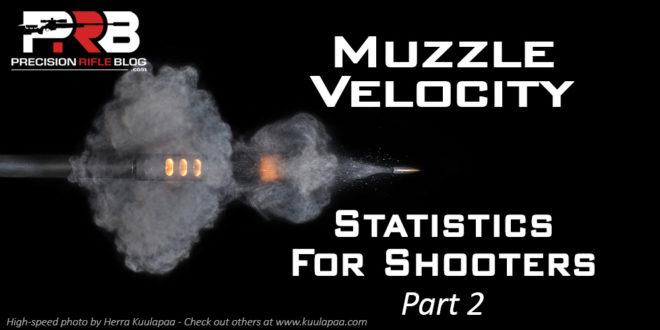Theres a hornady podcast that talks about this. I think there was a thread on here with it. From their take it's at least 30 shots preferably a hundred lol. They go into the science of the statistics bell curve etc. very interesting.What would be the ideal number of rounds fired to make meaningful inferences, 10-20?
Thanks
You are using an out of date browser. It may not display this or other websites correctly.
You should upgrade or use an alternative browser.
You should upgrade or use an alternative browser.
SD/ES question
- Thread starter haisardao
- Start date
 Help Support Long Range Hunting Forum
Help Support Long Range Hunting Forum
Axl
Well-Known Member
The only thing that matters!Question for the group, I'm a little puzzle and happy to hear all you guys opinions.
While loading for my 300 Rum one 5 shot group has an ES/SD of 15/7 and the other 31/14. These rounds were loaded exactly the same, at the same time, everything same lot. Would you consider this an expected variation or I'm messing up somewhere without knowing. Groups are great but that inconsistency bothers my obsessive personality. Thanks I'm advanced
H
RockyMtnMT
Official LRH Sponsor
@Axl beat me to it. He is correct. The target means way more than the es. You would be hard pressed to shoot the diff in a 30 fps spead at 1000y. It is always great to be able to pat yourself on the back if you get single digit es. What really sucks is when you have single digit es and the load shoots like crap!
Thanks, appreciate everyone input. I guess I'll keep slinging Hammers and printing small groups.@Axl beat me to it. He is correct. The target means way more than the es. You would be hard pressed to shoot the diff in a 30 fps spead at 1000y. It is always great to be able to pat yourself on the back if you get single digit es. What really sucks is when you have single digit es and the load shoots like crap!
QuietTexan
Well-Known Member
Before I say anything more - this is just math, and the OP has never mentioned shooting at a distance far enough for ES/SD to matter much if at all. If he stays 500 yards or in the ES/SD basically don't matter at all and he'll gain significantly more improvement through range and wind call improvement on any given shot than changing up a load that prints decently. Muzzle velocity statistics and BC % variation are long-range (1200+ yard) topics, inside that range I agree that pretty much all that matters is the group size because that wraps up all the p[possible variables in a final result.
I use ATC instead of max spread for group size because it's more useful in layering results of multiple short strings, especially for something like a 300 RUM where if you care about the barrel you don't want to send 30 in a row down it without letting it cool down.
That said, here's some math that doesn't really matter:
The ES of his very few shots were 31fps, but the inference to be made from the small sample is that the ES of any future group of 5 shots will be ~75-100 FPS (5-6x SD around the mean velocity) - if he shoots enough of them he'll eventually get a huge ES.
Cal Zandt documented an SD 5.5/ ES 2 over 36 shots on a Lab Radar in one of his articles. That is an exceptional load because the ES is ~5x of SD, so the sample has already started to show normalization at the extreme ends. If the population has SD bands that matched a normal curve then he'd found a load that shows the type of consistency that will shoot well at long-range. Considering I think that was the 300 Norma he won the NF Steel Challenge with, that rifle worked out very well for him. But that was also shot at a distance where muzzle velocity stats mattered, not at or under 1000 yards.

 precisionrifleblog.com
precisionrifleblog.com
I use ATC instead of max spread for group size because it's more useful in layering results of multiple short strings, especially for something like a 300 RUM where if you care about the barrel you don't want to send 30 in a row down it without letting it cool down.
That said, here's some math that doesn't really matter:
Yes I agree that a 30FPS ES would be great..... the issue is that for all future shots that his ES isn't really 31FPS, just like how in the 3-shot single digit ES/SDs that get posted the ES isn't really 1-9FPS.You would be hard pressed to shoot the diff in a 30 fps spead at 1000y.
The ES of his very few shots were 31fps, but the inference to be made from the small sample is that the ES of any future group of 5 shots will be ~75-100 FPS (5-6x SD around the mean velocity) - if he shoots enough of them he'll eventually get a huge ES.
Cal Zandt documented an SD 5.5/ ES 2 over 36 shots on a Lab Radar in one of his articles. That is an exceptional load because the ES is ~5x of SD, so the sample has already started to show normalization at the extreme ends. If the population has SD bands that matched a normal curve then he'd found a load that shows the type of consistency that will shoot well at long-range. Considering I think that was the 300 Norma he won the NF Steel Challenge with, that rifle worked out very well for him. But that was also shot at a distance where muzzle velocity stats mattered, not at or under 1000 yards.

Muzzle Velocity Stats – Statistics for Shooters Part 2
Consistent muzzle velocity is key for long-range shooting, otherwise, bullets that leave the muzzle...
Thank for your reply and input, I almost never shoot at game last 600 yards.Before I say anything more - this is just math, and the OP has never mentioned shooting at a distance far enough for ES/SD to matter much if at all. If he stays 500 yards or in the ES/SD basically don't matter at all and he'll gain significantly more improvement through range and wind call improvement on any given shot than changing up a load that prints decently. Muzzle velocity statistics and BC % variation are long-range (1200+ yard) topics, inside that range I agree that pretty much all that matters is the group size because that wraps up all the p[possible variables in a final result.
I use ATC instead of max spread for group size because it's more useful in layering results of multiple short strings, especially for something like a 300 RUM where if you care about the barrel you don't want to send 30 in a row down it without letting it cool down.
That said, here's some math that doesn't really matter:
Yes I agree that a 30FPS ES would be great..... the issue is that for all future shots that his ES isn't really 31FPS, just like how in the 3-shot single digit ES/SDs that get posted the ES isn't really 1-9FPS.
The ES of his very few shots were 31fps, but the inference to be made from the small sample is that the ES of any future group of 5 shots will be ~75-100 FPS (5-6x SD around the mean velocity) - if he shoots enough of them he'll eventually get a huge ES.
Cal Zandt documented an SD 5.5/ ES 2 over 36 shots on a Lab Radar in one of his articles. That is an exceptional load because the ES is ~5x of SD, so the sample has already started to show normalization at the extreme ends. If the population has SD bands that matched a normal curve then he'd found a load that shows the type of consistency that will shoot well at long-range. Considering I think that was the 300 Norma he won the NF Steel Challenge with, that rifle worked out very well for him. But that was also shot at a distance where muzzle velocity stats mattered, not at or under 1000 yards.

Muzzle Velocity Stats – Statistics for Shooters Part 2
Consistent muzzle velocity is key for long-range shooting, otherwise, bullets that leave the muzzle...precisionrifleblog.com
DoneNOut
Well-Known Member
I've been at this long enough to know which load is the goldy locks. Like the one that doesn't take every ounce of absolute perfect application of the marksmanship fundamentals to stack lead in the same hole. The one that lets me get away with some known error on the shot. If I'm having a hard time in load development, I will take a rifle I know I got dialed in to confirm it.What would be the ideal number of rounds fired to make meaningful inferences, 10-20?
Thanks
okie man
Well-Known Member
- Joined
- Dec 21, 2013
- Messages
- 1,040
You can gain 15-25fps just letting a round sit in a hot chamber as you monkey with your rest longer than the previous round. Ten shots through the same conditions , barrel temp, chamber temp , air temp ect. Is better than 30 ran in groups without time for the gun to cool . With a big dose of powder things heat up and change quickly. A nice evenly paced 10 shots over the coarse of a hour or so will give you a better average than 2 5 shot groups 15 minutes apart.
This is where storing and shooting firearms and ammunition in a temp controlled environment would be fun. By monitoring the temp of ammo , the guns barrel and and environment , the collected data would be much more accurate.
For my own standards and needs in a hunting rifle, going out in 3 or 4 totally different conditions with a rifle and putting together solid moa or better 3 shot groups in each of those conditions at extended range is all I care about. That includes using your rangefinder/ballistic app, bipod or shooting sticks, ect. If you hunt in mountains I would add shooting uphill and downhill to the test also.
This is where storing and shooting firearms and ammunition in a temp controlled environment would be fun. By monitoring the temp of ammo , the guns barrel and and environment , the collected data would be much more accurate.
For my own standards and needs in a hunting rifle, going out in 3 or 4 totally different conditions with a rifle and putting together solid moa or better 3 shot groups in each of those conditions at extended range is all I care about. That includes using your rangefinder/ballistic app, bipod or shooting sticks, ect. If you hunt in mountains I would add shooting uphill and downhill to the test also.